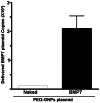BMP7 gene transfer via gold nanoparticles into stroma inhibits corneal fibrosis in vivo
- PMID: 23799103
- PMCID: PMC3682981
- DOI: 10.1371/journal.pone.0066434
BMP7 gene transfer via gold nanoparticles into stroma inhibits corneal fibrosis in vivo
Abstract
This study examined the effects of BMP7 gene transfer on corneal wound healing and fibrosis inhibition in vivo using a rabbit model. Corneal haze in rabbits was produced with the excimer laser performing -9 diopters photorefractive keratectomy. BMP7 gene was introduced into rabbit keratocytes by polyethylimine-conjugated gold nanoparticles (PEI2-GNPs) transfection solution single 5-minute topical application on the eye. Corneal haze and ocular health in live animals was gauged with stereo- and slit-lamp biomicroscopy. The levels of fibrosis [α-smooth muscle actin (αSMA), F-actin and fibronectin], immune reaction (CD11b and F4/80), keratocyte apoptosis (TUNEL), calcification (alizarin red, vonKossa and osteocalcin), and delivered-BMP7 gene expression in corneal tissues were quantified with immunofluorescence, western blotting and/or real-time PCR. Human corneal fibroblasts (HCF) and in vitro experiments were used to characterize the molecular mechanism mediating BMP7's anti-fibrosis effects. PEI2-GNPs showed substantial BMP7 gene delivery into rabbit keratocytes in vivo (2×10(4) gene copies/ug DNA). Localized BMP7 gene therapy showed a significant corneal haze decrease (1.68±0.31 compared to 3.2±0.43 in control corneas; p<0.05) in Fantes grading scale. Immunostaining and immunoblot analyses detected significantly reduced levels of αSMA (46±5% p<0.001) and fibronectin proteins (48±5% p<0.01). TUNEL, CD11b, and F4/80 assays revealed that BMP7 gene therapy is nonimmunogenic and nontoxic for the cornea. Furthermore, alizarin red, vonKossa and osteocalcin analyses revealed that localized PEI2-GNP-mediated BMP7 gene transfer in rabbit cornea does not cause calcification or osteoblast recruitment. Immunofluorescence of BMP7-transefected HCFs showed significantly increased pSmad-1/5/8 nuclear localization (>88%; p<0.0001), and immunoblotting of BMP7-transefected HCFs grown in the presence of TGFβ demonstrated significantly enhanced pSmad-1/5/8 (95%; p<0.001) and Smad6 (53%, p<0.001), and decreased αSMA (78%; p<0.001) protein levels. These results suggest that localized BMP7 gene delivery in rabbit cornea modulates wound healing and inhibits fibrosis in vivo by counter balancing TGFβ1-mediated profibrotic Smad signaling.
Conflict of interest statement
Figures











Similar articles
-
Long-Term Safety and Tolerability of BMP7 and HGF Gene Overexpression in Rabbit Cornea.Transl Vis Sci Technol. 2021 Aug 12;10(10):6. doi: 10.1167/tvst.10.10.6. Transl Vis Sci Technol. 2021. PMID: 34383876 Free PMC article.
-
Novel Combination BMP7 and HGF Gene Therapy Instigates Selective Myofibroblast Apoptosis and Reduces Corneal Haze In Vivo.Invest Ophthalmol Vis Sci. 2018 Feb 1;59(2):1045-1057. doi: 10.1167/iovs.17-23308. Invest Ophthalmol Vis Sci. 2018. PMID: 29490341 Free PMC article.
-
Significant inhibition of corneal scarring in vivo with tissue-selective, targeted AAV5 decorin gene therapy.Invest Ophthalmol Vis Sci. 2011 Jul 1;52(7):4833-41. doi: 10.1167/iovs.11-7357. Invest Ophthalmol Vis Sci. 2011. PMID: 21551414 Free PMC article.
-
The corneal fibrosis response to epithelial-stromal injury.Exp Eye Res. 2016 Jan;142:110-8. doi: 10.1016/j.exer.2014.09.012. Exp Eye Res. 2016. PMID: 26675407 Free PMC article. Review.
-
Two-phase mechanism in the treatment of corneal stromal fibrosis with topical losartan.Exp Eye Res. 2024 May;242:109884. doi: 10.1016/j.exer.2024.109884. Epub 2024 Apr 1. Exp Eye Res. 2024. PMID: 38570181 Review.
Cited by
-
NBL1 Reduces Corneal Fibrosis and Scar Formation after Wounding.Biomolecules. 2023 Oct 24;13(11):1570. doi: 10.3390/biom13111570. Biomolecules. 2023. PMID: 38002252 Free PMC article.
-
Role of Bone Morphogenetic Protein 7 (BMP7) in the Modulation of Corneal Stromal and Epithelial Cell Functions.Int J Mol Sci. 2018 May 9;19(5):1415. doi: 10.3390/ijms19051415. Int J Mol Sci. 2018. PMID: 29747422 Free PMC article.
-
Long-Term Safety and Tolerability of BMP7 and HGF Gene Overexpression in Rabbit Cornea.Transl Vis Sci Technol. 2021 Aug 12;10(10):6. doi: 10.1167/tvst.10.10.6. Transl Vis Sci Technol. 2021. PMID: 34383876 Free PMC article.
-
The expression of Smad signaling pathway in myocardium and potential therapeutic effects.Histol Histopathol. 2017 Jul;32(7):651-659. doi: 10.14670/HH-11-845. Epub 2016 Nov 15. Histol Histopathol. 2017. PMID: 27844469 Free PMC article. Review.
-
Progress in corneal wound healing.Prog Retin Eye Res. 2015 Nov;49:17-45. doi: 10.1016/j.preteyeres.2015.07.002. Epub 2015 Jul 18. Prog Retin Eye Res. 2015. PMID: 26197361 Free PMC article. Review.
References
-
- Bedei A, Marabotti A, Giannecchini I, Ferretti C, Montagnani M, et al. (2006) Photorefractive keratectomy in high myopic defects with or without intraoperative mitomycin C: 1-year results. Eur J Ophthalmol 16: 229–234. - PubMed
-
- Camellin M (2004) Laser epithelial keratomileusis with mitomycin C: indications and limits. J Refract Surg 20: S693–S698. - PubMed
Publication types
MeSH terms
Substances
Grants and funding
LinkOut - more resources
Full Text Sources
Other Literature Sources
Medical
Research Materials

